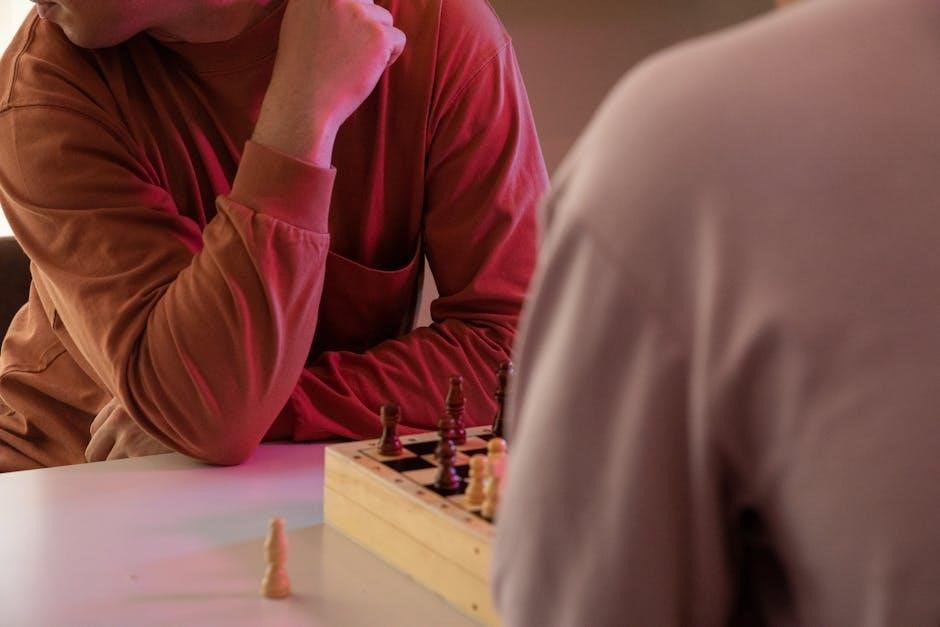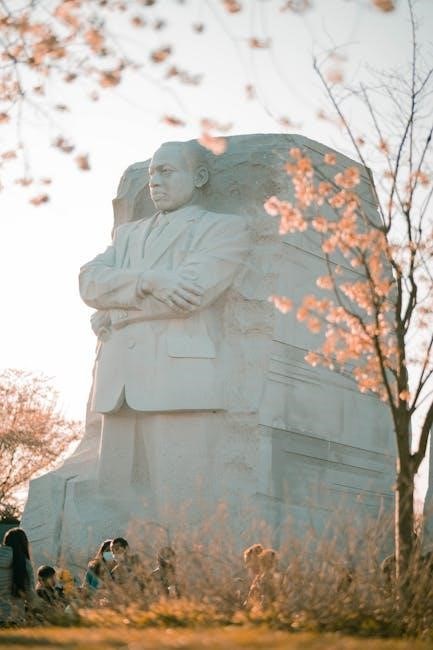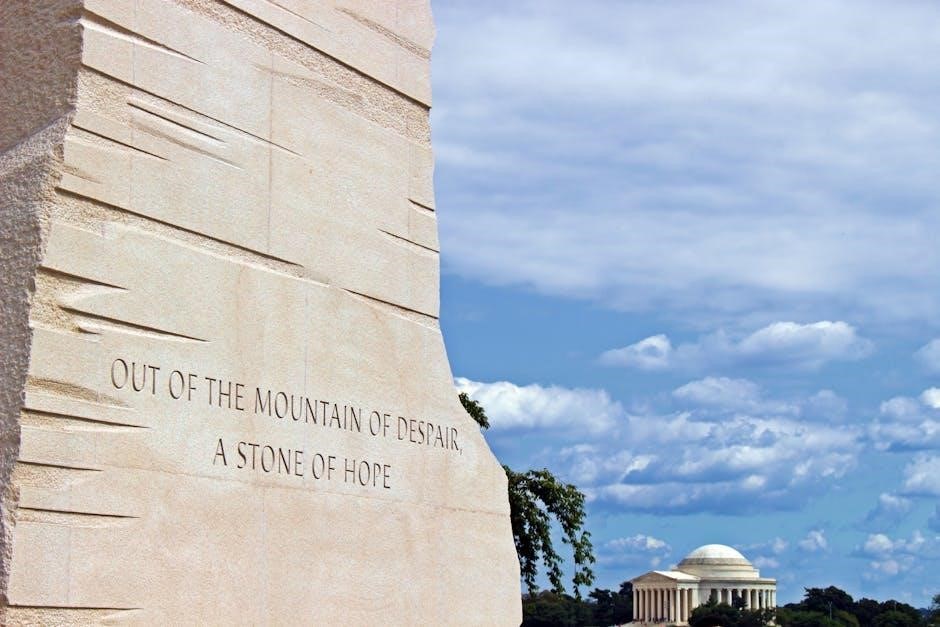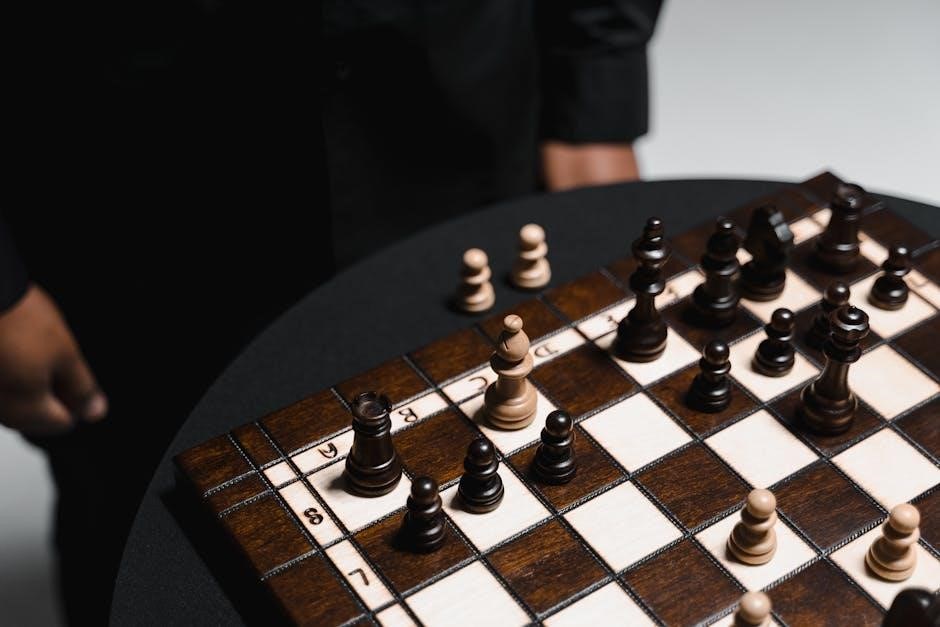Engage students with meaningful MLK Jr. educational activities that promote diversity, equality, and social justice. These activities, including timelines, letter writing, and service projects, inspire empathy and critical thinking while fostering a deeper understanding of Dr. King’s legacy and its relevance today.
Overview of MLK Jr.’s Importance in Education
Dr. Martin Luther King Jr. plays a pivotal role in education by inspiring lessons on equality, justice, and diversity. His life and teachings emphasize the importance of critical thinking, empathy, and moral character. Schools use his legacy to foster inclusive environments, encouraging students to reflect on social justice and activism. King’s vision of a unified society aligns with educational goals of promoting understanding and respect among diverse groups. His speeches and actions serve as powerful tools for engaging students in discussions about history, civil rights, and the ongoing struggle for equality. By integrating his story into curricula, educators help students connect past achievements with present-day challenges, fostering a compassionate and informed future generation;
Timeline of MLK Jr.’s Life
Dr. Martin Luther King Jr. was born in 1929, led the 1955 Montgomery Bus Boycott, delivered his iconic “I Have a Dream” speech in 1963, and was assassinated in 1968.
Creating a Timeline Activity
Creating a timeline of Dr. Martin Luther King Jr.’s life is an engaging way to help students understand his journey and contributions. Start by gathering key dates, such as his birth in 1929, the Montgomery Bus Boycott in 1955, the “I Have a Dream” speech in 1963, and his assassination in 1968. Students can work in groups to research and organize these events chronologically. Use a large poster or digital tool to display the timeline, allowing students to add images, quotes, or explanations for each milestone. This activity encourages critical thinking and collaboration while providing a visual representation of Dr. King’s life and legacy. It also helps students connect historical events to modern-day issues of equality and justice.
Writing Activities
Engage students in writing activities that explore Dr. King’s impact, fostering empathy and critical thinking about equality and justice through creative and reflective exercises.
Letter Writing to MLK Jr.
Engage students in writing heartfelt letters to Dr. Martin Luther King Jr., expressing gratitude for his contributions and sharing their thoughts on equality and justice. This activity encourages students to reflect on Dr. King’s legacy and its impact on their lives. By writing letters, students develop empathy and understand the significance of his work in promoting civil rights. This meaningful exercise helps students connect with historical figures on a personal level while fostering critical thinking about social justice. Letters can be written in a classroom setting, guided by templates or creative freedom, allowing students to voice their aspirations for a fairer world. This activity is both educational and emotionally enriching, helping students appreciate Dr. King’s enduring influence.
Creating an “I Have a Dream” Wall
Engage students in creating an “I Have a Dream” Wall, inspired by Dr. Martin Luther King Jr.’s iconic speech. This activity fosters creativity and reflection as students brainstorm and share their own dreams for equality, justice, and a better world. Begin by discussing the significance of Dr. King’s vision, then have students write or draw their aspirations on paper strips or cards. These contributions are then displayed on a classroom wall, creating a powerful visual representation of collective hopes. This activity encourages students to think critically about social justice and equality while connecting with Dr. King’s message. It also promotes collaboration and unity, as students see their ideas come together in a shared space. This meaningful project inspires young minds to envision a brighter future, just as Dr. King did.

Discussing MLK Jr.’s Speeches
Explore Dr. King’s powerful speeches to inspire critical thinking and reflection. Analyze his words, their impact, and relevance today, fostering deeper understanding of his vision and legacy.
Analyzing the “I Have a Dream” Speech
Dr. Martin Luther King Jr.’s “I Have a Dream” speech is a cornerstone of civil rights education. Students can analyze its structure, rhetoric, and historical context to understand its power. Activities include identifying key themes like equality and justice, discussing the emotional impact of his words, and reflecting on how his vision applies today. Teachers can use guided discussions, written reflections, or multimedia presentations to deepen comprehension. This analysis fosters critical thinking, empathy, and a connection to Dr. King’s enduring message of hope and unity. By exploring this speech, students gain a richer understanding of its significance and relevance in modern society.
Book Recommendations for the Classroom
Engage students with books like My Daddy, Dr. Martin Luther King Jr. and Martin’s Big Words, which explore Dr. King’s life, legacy, and message of equality and love.
My Daddy, Dr. Martin Luther King Jr.
My Daddy, Dr. Martin Luther King Jr. by Martin Luther King III offers a heartfelt perspective on Dr. King’s life through the eyes of his son. This touching narrative highlights Dr. King’s role as a father and his unwavering commitment to justice and equality. Written for children, the book provides a relatable and accessible way to introduce young students to Dr. King’s legacy. It emphasizes themes of love, family, and the importance of standing up for what is right. The story also underscores the human side of Dr. King, showing him as a caring parent while also being a global leader. This book is an excellent choice for classroom reading, fostering discussions about diversity, kindness, and the impact one person can have on the world. Pairing this with a discussion guide or reflection activity can deepen students’ understanding and appreciation of Dr. King’s work.
Martin’s Big Words: The Life of Dr. MLK Jr.
Martin’s Big Words: The Life of Dr; Martin Luther King Jr. is a powerful and inspiring book that introduces students to Dr. King’s life and legacy. Written by Doreen Rappaport, this biography uses Dr. King’s own words to highlight key events and principles that defined his journey. The book emphasizes themes of peace, love, and equality, making it an excellent resource for teaching students about the civil rights movement. Classroom activities such as reading discussions, vocabulary building, and reflection exercises can enhance understanding. The story’s accessible language and impactful messages make it suitable for younger students, helping them grasp the significance of Dr. King’s contributions. This book serves as a valuable tool for fostering empathy and encouraging students to think critically about justice and equality in their own lives and communities.

Classroom Discussions
Foster meaningful conversations about diversity, equality, and social justice. Use Dr. King’s teachings to inspire empathy and critical thinking, connecting his legacy to contemporary issues and student experiences.
Teaching Diversity and Equality
Dr. Martin Luther King Jr.’s vision of equality and justice serves as a powerful foundation for teaching diversity in the classroom. By incorporating discussions and activities that highlight his teachings, students can gain a deeper understanding of the importance of inclusivity and respect for all individuals. Activities such as group discussions, reflection exercises, and collaborative projects encourage students to explore their own identities and experiences while fostering empathy for others. These lessons not only promote social-emotional growth but also align with Dr. King’s legacy of advocating for a more equitable society. By integrating these principles into everyday learning, educators can help students become compassionate and open-minded individuals who actively contribute to creating a fair and just world.
Volunteering as a Class Activity
Volunteering as a class activity is a meaningful way to honor Dr. Martin Luther King Jr.’s legacy of service and community impact. By organizing projects such as food drives, park cleanups, or visiting nursing homes, students can embody Dr. King’s belief in giving back to society. These activities foster teamwork, empathy, and a sense of social responsibility while connecting students to real-world issues. Educators can tie these efforts to Dr. King’s vision of a more just and compassionate world, helping students understand the value of collective action. Volunteering not only enriches the community but also deepens students’ appreciation for Dr. King’s teachings and their relevance today. It’s a hands-on way to celebrate his message of service and equality.

Art and Creative Projects
Engage students in creative art projects inspired by Dr. King’s legacy, such as crafting “I Have a Dream” mobiles or diversity murals, fostering creativity and reflection on his message of equality and unity.
Creating an “I Have a Dream” Mobile
Encourage students to craft a vibrant “I Have a Dream” mobile, symbolizing Dr. King’s vision of equality and unity. Using construction paper, string, and glue, students can design dream clouds, peace doves, or inspirational quotes from MLK Jr.’s speeches. Each element represents a hope or aspiration for a better world, fostering creativity and reflection. This activity connects art with history, allowing students to visually express their understanding of Dr. King’s message. Displaying the mobiles in the classroom or school hallway creates a collective exhibit of shared dreams, inspiring dialogue about diversity and social justice. This hands-on project aligns with Dr. King’s belief in the power of imagination and collective action to drive positive change.

Service Learning and Community Activities
Foster compassion and social responsibility through service learning. Organize community clean-up projects, food drives, or volunteer days, reflecting Dr. King’s commitment to serving others and promoting equality.
Organizing a Day of Service
Organizing a Day of Service is a powerful way to honor Dr. Martin Luther King Jr.’s legacy of compassion and activism. Start by planning community-focused projects such as food drives, park cleanups, or volunteering at local shelters. Collaborate with students, parents, and community organizations to maximize impact. Assign roles to ensure smooth execution, such as coordinators, promoters, and participants. Integrate educational components by discussing Dr. King’s commitment to service and its relevance today. Reflect on the experience through group discussions or written reflections, emphasizing how small actions can create meaningful change. This activity not only fosters teamwork but also teaches the value of giving back, aligning with Dr. King’s vision of a just and equitable society.
Dr. Martin Luther King Jr.’s educational activities inspire students to embrace diversity, equality, and service, fostering a lasting impact on their understanding of his enduring legacy.
Summarizing the Impact of MLK Jr. Activities
Engaging in Martin Luther King Jr. educational activities fosters a deeper understanding of his legacy and promotes values of equality, justice, and compassion. These activities, such as timelines, letter writing, and service projects, empower students to connect with Dr. King’s vision of a unified society. By exploring his contributions to civil rights, students develop empathy and critical thinking skills. The activities also encourage community involvement, inspiring young learners to become agents of positive change. Through these meaningful experiences, students gain a profound appreciation for Dr. King’s impact and are motivated to continue his work toward a more equitable world.
